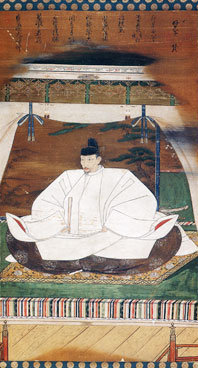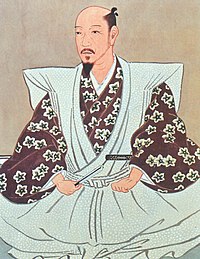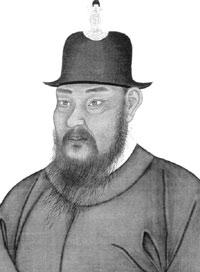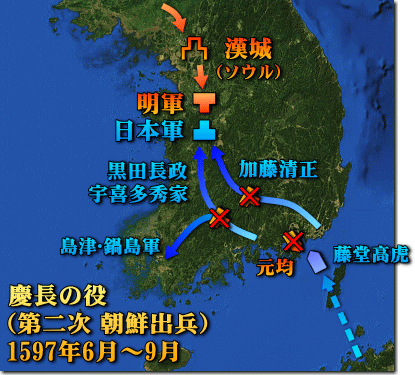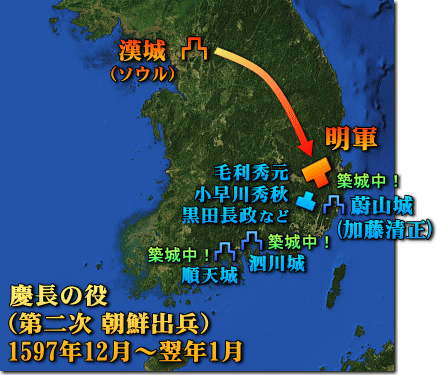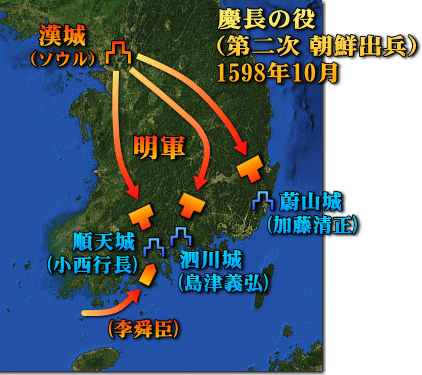The Imjin war (the late 16th century war where Japan invaded Korea, and the Ming dynasty Chinese ended up sending a large army to try and aid the Koreans ) is one that probably perk the fancy of many, as it was the only pre-modern Japanese invasion on a large scale, and it coincided with the height of the Samurai era, and it involved 3 of the preeminent East Asian culture of the time. The real war records left behind at the time is really very complete, yet unfortunately distorted since the begining of the 20th century of many obvious reasons (tools of imperialism, tools of nationalism, tools of Samurai mania, you name it)
I'll start a post that trys to bring a relatively simple , complete, balanced view on this war. trying to both help the beginners while staying true to sources.
To start. let's get an overview of how the war actually went down.
------------------------------------------------------------------------------------------------------
Stage 1: the Invasion
May - August of 1592
The Japanese forced landed in late May of 1592, and they basically swepted aside the woefully unprepared and inexperienced Korean forces. within 20 days they had already marched up to the capital city of Seoul, and took PyongYang a little less than a month later.
By August of 1592, the 3 most important Korean cities of the time (Seoul / PyongYang / Kaesong) had all fallen to Japanese hands (and all 3 were lost without a real fight), while even the more remote provinces were being overran by Japanese . only a few pocket of resistence (most notabbly in the South Western Province of Jelloa) remained. the Japanese army even managed to drive right up to the Yalu river that bordered China, and even send a scouting party across the border briefly)
Stage 2: bogged down
September of 1592-January of 1593
Although the Japanese exploded into Korea almost uncontested , they begin to run into trouble after taking PyongYang, as their lines were stretched long and thin they begin to get harrased badly by the various groups of insurgent Koreans.
While things looked even worse at sea, as the Korean fleet under Admiral Yi Sun Sin handed them defeat after defeat. topped off by the battle of Hansando in mid August. where the bulk of the Japanese fleet was annihilated .
These problems begin to throw the Japanese into a quagmire mode. where the Koreans can't really do anything against their army. but they in turn can't really do much about their situation. as they have poor control of anything out of their immediate vicinity. and food supplies become increasingly more problematic. only a small portion of Koreans were willing to work with them at all, while many rose up in arms against the foreign invaders.
Stage 3: the Ming expedition
January 1593-May 1593
Although the Ming made some initial attempts to relieve the Koreans by around August of 92, they were generally confused by the news comming in, as it was difficult to comprehend how their ally could have fallen so swiftly and decisively in such a short period. After sending their own investigation and having some of their small initial parties badly crushed. they decided to make a complete effort by late September of 1593
Song YingChang was named as the chief overseer of the expedition , and the administrator assembled an army of some 36000 by late December of 1592. with the general Li Ru Song as his main comamnder. The expedition crossed the Yalu river right around the turn of the new year.
The expedition was generally successful. they arrived quickly outside of PyongYang, and after some initial attempt of bartering they defeated the Japanese force in a single day assault. for the first time in the war the Japanese suffered a serious defeat on land.
The expedition's success at PyongYang prompted all the Japanese forces in northern parts of the Country to pull back south. concentrating around the capital of Seoul. meanwhile the Ming also retook a largely abandoned Kaesong soon after the sack of PyongYang.
By late January the Ming forces begin to move against the capital city of Seoul. their initial attempt backfired as they had been misled into believing that like Kaesong, the Japanese were about to give up on Seoul as well. this prompted the Ming general to move ahead with mostly their cavalry and leaving their infantry to march nearly a day behind them. They soon ran into a large Japanese force just north of Seoul and although they escaped relatively in one piece. this battle forced them to reconsider their strategy and they temporarily pulled back to Kaesong.
Meanwhile, one of the most prominent insurgent Koran General Kwon Yul had taken a key fortress at Haenju just north of Seoul as part of the combined effort to move against Seoul, when the Ming forces was set back they in turn was trapped deep in enemy territory and soon a large Japanese force were knocking on their gate.
However, the much smaller Korean forces managed to defend the small fortress succesfully. dealing a very devastating blow to the Japanese forces. it was probably the single most succesful operation by the Korean forces on land in the war.
Encouraged by this success, the Ming army moved against Seoul again not long after. The two sides basically remained at stalemate with neither side willing to commite to a fight for the next couple of month outside of the Seoul area.
However, the Japanese logistical situation was growing dire, and made worse when a combined Ming / Korean special operation managed to burn down one of their largest grain storage.
They begin to sue for peace, and as part of the negotiation they pulled out of Seoul uncontested. With the ally forces' entrance into Seoul and the return of the Korean court to their capital. this marked the end of the first war.
Stage 4: failed peace talk
May 1593 - July 1597
Although the Ming and Japanese entered into peace talks after mid 1593, they were too far apart to begin with and had both misunderstood each other badly. combined with possible deception on their delgation's part, the talks really went no where and by 1597 it finally collapsed . as the Ming thought they were simply trying to woo another fring tribal chieftan who had some modest military success in a far away border. Their final ceremony for Toyotomi Hideoyoshi was met with wrath and anger and soon they were throw out of Japan. the failed peace talk would also prove disastorous for the Ming delgations as their lead negotiator was executed and many of the high ranking officials that lead the peace talks back home was purged.
Stage 5: The second invasion
July 1597 - Septermber 1597
With the breakdown of peace talks the Japanese unleashed their fury on Korea again, but this time the Koreans were far more prepared on land, and progress turned out much slower for the Japanese.
However, on the other end of the specturm the Japanese were far more prepared at sea. and combined with what was either a clever double agent plot or simply the incompetence of the Joseon court, which had removed and jailed their best admiral right at the start of this new round of fighting. the end result was that a less competent admiral lead the Korean navy to a disastorous defeat in mid August.
The naval defeat also gave the Japanese a break on land, and they were able to break through the ally defenses, including taking the key garrison of Namwon, where 3000 Ming forces with 3000 Koreans were annihilated .
Stage 6: the tide turns again
September 1597 - December 1597.
After the naval debatical the Joseon dynasty appeared to be on the brink again, after the garrison in Namwon was lost, most of southern Korea fell back into the Japanese hand and they marched towards Seoul by September.
The court was in full panic and even the Ming generals stationed in Korea
adviced for them to pull back with the Ming forces to PyongYang and wait until reinforcements arrive in full. However the Ming administrators overruled the generals and ordered them to defend Seoul at all cost.
The Ming generals send an elite force of cavalries some 2000 strong along with 2000 additional reinforcing cavalries and intercepted the Japanese advance at Jiksan. Though there are some conflicting account to how the battle actually went down, it seemed that the Ming forces were able to utilize cavalry tactics succesfully against the Japanese, and they were forced back. this marked their high water mark on land.
During all this, the Joseon court also hastily and embarrsingly released Admiral Yi and restored his position. with only a handful of ships left from the previous disastor. Yi never the less crushed the Japanese fleet only days after the battle of Jiksan. these two victory marked the turning point of the war.
After this, the Koreans work to build up their navy again.
With the arrival of the intial Ming reinforcement (which brought their overall numbers back to around the 40K range ) the Ming army drove south in their first attempt to counter attack the Japanese. they had the Japanese force surprised and pinned down at the fortress of Ulsan in December of 1597.
However, the Ming forces met tough defenses at Ulsan , along with some management error on the Ming part. they went scuffing in defeat as a Japanese relieve force managed to pull off a succesful surprise attack in the cover of heavy rain. a confusing attempt to retreat without warning send the allied forces into chaos and eventually a near full rout back towards Seoul.
Stage 7: the final stretch
Even after turning back the Allied forces at Ulsan, the Japanese were unable to make much headways into Korea . the two side fought to a stalemate as the Japanese were again in tough shape at sea while the Ming waited for additional reinforcements and the regroup the supplies they lost at Ulsan (and the Korean to rebuild their navy) through most of winter and early Spring.
By then, the health of Toyotomi Hideyoshi was deterioiating and he had more or less decided to discontinue the war. by pulling out a good portion of his troops in early 1598 he had basically left just enough men to defend the Southern coast of Korea (some 50-60K)
By mid 1598, the Ming reinforcement had arrived in full. and a new offensive begin to take place. In September of 1598 the Ming launched the final massive offensive of the war on the Japanese positions . Seperating their army into 3 groups. they headed for the 3 final Japanese strong hold guarding the line into their headquoter at Busan. with Ma gui heading the offensive up north against the defenses lead by Kato Kiyomasa at Ulsan yet again, Dong Yi Yuan attack the center fortress at Sacheon against the head of the Shimazu clan Shimazu Yoshihiro , and Liu Ting attacking the Southern fortress of Suncheon defended by Konishi Yukinaga in a combined effort with the combined fleet of Yi Sun Sin and the Ming admiral Chen Lin. The ally forces, land and sea combined, now run over 100K strong with several hundred ships.
The offensive did not actually go well, Ulsan went back and forth without any sort of decisive battle during the offensive, while the Ming ran into disastor at Sacheon, when their artillery crew had a gunpowder accident during their siege and blew up their whole camp with their own gunpowder, the Shimazu forces seized the moment and sallied out (they were in deep trouble up to this point, as their outer walls were already breached and even the gates of the inner war was shattered by the Ming artillery.) . The Ming forces were already devasted by the explosion and promptedly routed by the sallying forces.
At Suncheon the battle also did not go well. as either due to some miscommunication or perhaps personal grudges between the Ming generals. the land sea coordination efffort was poor, as Chen Lin and Yi Sun Shin launched a daring assault from the sea during high tide. the forces on land lead by Liu Ting for some inexplicable reason did not follow up the attack on land. even though there were reports of the walls on the land side being almost completely abandoned while the Japanese defender scramble to defend against the sea attack. The attack resulted in several of the Ming and a few Korean ship being trapped on land when the tide went out. and many of its crew (espeically the Ming crews. who were operating on smaller ships and was closer up to the fortress, the Korean crew mostly was able to defend themself on their bigger ships until the tide went up again.) was killed.
However, right around this time Toyotomi Hideoyoshi died, and the Japanese decided to make a final daring retreat. Chen Lin hesistated to give chase at the initial news of the retreat (and possibly agreed to let the Japanese just leave ) but Yi Sun Sin rushed foward. Chen then decided the Yi was right and followed him to the straits of Noryang .
The final epic showdown of Noryang was basically a one sided slaughter, however as Chen Lin and his second in command Deng Zhi Long along with Yi Sun Sin all decided to manuver their ships ahead of the Japanese to cut them off, this put them directly into danger, in the end they were able to annihilate over 10k men at sea alone within a few hours, which was roughly 20% of the entire Japanese forces left on Korea at that time. the allied casualty was actually quite light, losing only a few hundred men in the battle. but among the casautlies were Yi Sun Sin and the Ming vice admiral Deng Zhi Long. as the 3 commander manuvered their flag ships in daring fashion ahead of the rest of their fleet.
------------------------------------------------------------------------------------------------------
Will continue with the notable figures in the war







 Reply With Quote
Reply With Quote





